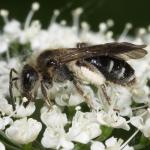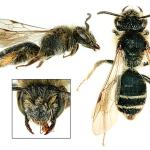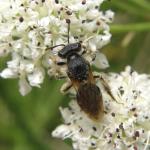Andrena digitalis KIRBY 1802
A medium-sized mining bee, the largest member of the Andrena minutula species-group (subgenus Micrandrena).
Widely distributed in southern Britain, but generally a rare species. Found throughout much of Europe, from Norway, Denmark, Poland and Latvia, south to Iberia, Italy and Greece.
Listed as Rare (RDB3) in Shirt (1987) and by Falk (1991).
Open sites, rich in flowering umbellifers (Apiaceae), both inland and on the coast.
Univoltine; mid May to late June.
The species nests either solitarily or in small aggregations, generally avoiding sandy soils (Kocourek 1966;Westrich 1989). Nests do not seem to have been discovered in Britain.
The bee has been reported to visit the flowers of Alexanders (Smyrnium olusatrum), cow parsley (Anthriscus sylvestris), hawthorn (Crataegus monogyna), hogweed (Heracleum sphondylium), rough chervil (Chaerophyllum temulum), a spurge (Euphorbia sp.) and a water-dropwort (Oenanthe sp.).
Nests are attacked by the cuckoo bee Nomada conjungens. On mainland Europe, stylopized individuals of A. proxima have been found, but these have not been reported from Britain.
2009




